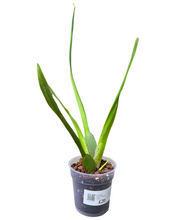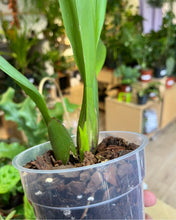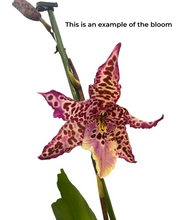These plants are no longer in bloom.
This is also known as a Cambria-type orchid, the Cambria group contains Oncidium, Miltonia, Brassia and Cochlioda.
Oncidium are part of the Orchidaceae family and their native range is Tropical & Subtropical America. They have a sympodial growth habit (the plant grows sideways and pseudobulbs are connected by thick rhizomes). It is said that Oncidium is the orchid which led to ‘Orchidmania’. Flowers spikes have a pendulous growth habit and don’t require the stakes (sometimes provided) for anything other than space saving.
Genus name is derived from the Greek word ὀγκος, meaning ‘swelling’, this is in reference to the callus at the lower lip.
Pot: ø 12cm.
Height: Approximately 55cm from base of pot.
Light: Bright indirect light, meaning the plant sees the sun for 0-4 hours per day - this could be through trees or a translucent curtain, it’s important for the plant to see the sky in order to thrive. East facing aspect with some shade from the sun during the brightest part of the day in spring and summer.
Water: Water with lukewarm water when the about ¾ potting mix is dry; if the plant is particularly dehydrated it’s pseudobulb will wrinkle and leaves may develop an accordion appearance.
Potting medium: Ideally pot in a chunky mix made up of pine bark, sphagnum moss and some horticultural charcoal.
Fertilising: Feed monthly using a well balanced fertiliser. You can further dilute fertiliser than the recommended amount but never add more. Alternatively, you could use a ‘Grow’ type fertiliser all year round and switch to a ‘Bloom’ formulation in autumn and winter.
Temperature: 10-14˚C; a cool period will help with flowering.
Humidity: Although Oncidium prefers higher humidity they do well to adapt to average home humidity.
Blooming information: Flowers typically last between 6-8 weeks, when the flowers are spent, it is safe to snip the flower spike, cutting as close to the base as possible with a sterilised tool.
Flower spikes typically emerge from in between the first leaf and the pseudobulb, Oncidium are able to produce more than one flower spike at a time. Oncidium don’t branch out or produce keikis like Phalaenopsis, they produce a new pseudobulb from the old pseudobulb. Don’t remove the old pseudobulbs as they are a water and nutrient store for the plant.
The plant is growing during spring and summer, when the temperature drops in autumn/winter it begins to initiate growth of a flower spike. This can vary as commercial greenhouses use temperature to ensure plants are in bloom when purchased so just bear with your plant if it has a dormant year. If your orchid doesn’t flower again within a year, it is likely due to excess warmth.
Oncidium are non-toxic.




